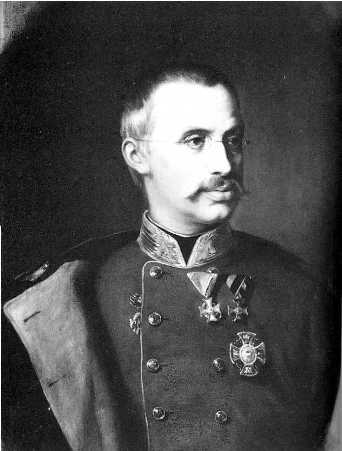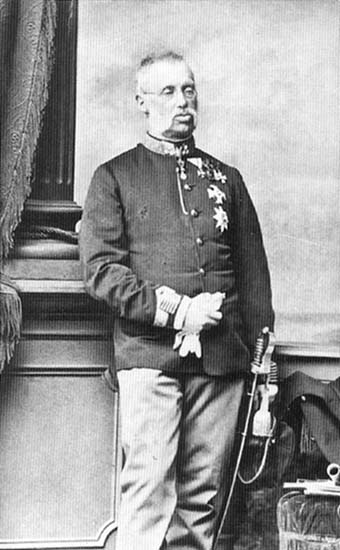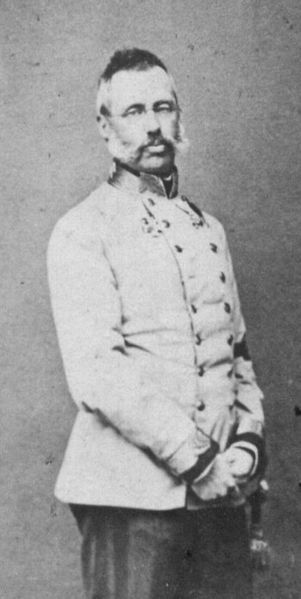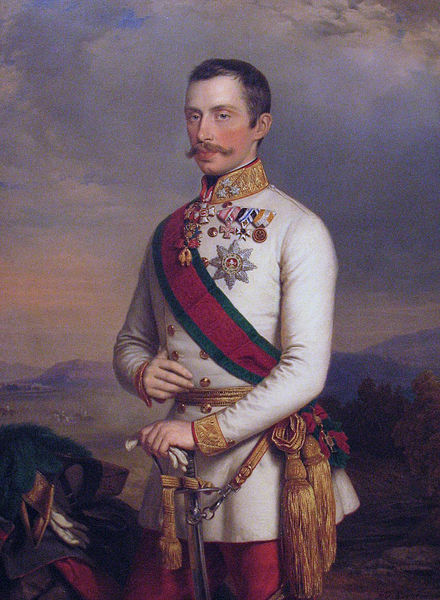<Back to Index>
- Engineer Pavel Petrovich Melnikov, 1804
- Architect Jeffry Wyattville, 1766
- Field Marshal of the Austro - Hungarian Army Archduke Albrecht Friedrich Rudolf Dominik, 1817
PAGE SPONSOR



Archduke Albrecht Friedrich Rudolf Dominik of Austria, Duke of Teschen (3 August 1817 – 18 February 1895) was an Austrian Habsburg general. Inspector General for 36 years, he was honored with the rank of Field Marshal in the armies of Austria - Hungary (1888) and Germany (1893).
He was the eldest son of Archduke Charles of Austria, who defeated Napoleon Bonaparte at Aspern (1809), and Princess Henrietta of Nassau - Weilburg. Born in Vienna, from an early age he had a military disposition, which his father encouraged. Albrecht was subject to a mild form of epilepsy, according to report, but this did not visibly interfere with his military career.
He entered the Austrian army in 1837 with Feldmarshal Joseph Radetzky as his military governor. Having received a thorough military education, Albrecht was named a Generalmajor in 1840 and promoted to Feldmarschall - Leutnant in 1843. Promoted to General der Kavallerie in 1845, Albert was given command of Upper Austria, Lower Austria, and Salzburg. Upon the death of his father in 1847, he inherited the Palais Weilburg in Baden bei Wien, which became the family's summer home. In the winter the family lived in Vienna in the Palais Erzherzog Albrecht (the modern Albertina museum). As the commandant of Vienna, Albrecht was wounded in the street fighting on 13 March 1848 at the start of the revolutionary disturbances.
He issued live ammunition to his soldiers and secured the inner city,
but was unable to suppress the disorder in the outlying districts. With
the fall of Metternich and the formation of a city guard led by students, Albrecht pulled his troops into barracks.
Radicals resented his attempt to quell the revolution while some fellow
officers thought he showed a lack of resolve. Unsatisfactory to both
factions and under pressure from city authorities, Albrecht was replaced by Count Auersperg. Albrecht was sent south to command a division under Radetzky, who faced a coalition of states of the Italian peninsula led by King Charles Albert of Sardinia. Albrecht personally supervised the crossing of the Ticino and by the handling of his division ensured victory at Novara on 23 March 1849. He
became civil and military governor of Hungary in 1851, serving until
his recall in 1860. When Archduchess Hildegard went to Munich in March
1864 for the funeral of her brother, King Maximilian II, she became ill
with a lung inflammation and pleurisy. She died in Vienna on 2 April
1864, two months short of her 38th birthday. At the outbreak of the Seven Weeks' War in
June 1866, Albrecht was named commander of the southern army facing the
Italian forces of King Victor Emmanuel II. Albrecht was decisively
victorious in the battle of Custoza (24 June 1866), but failed to exploit his victory when he neglected to pursue the beaten Italian Army of the Mincio. Any advantages for the Austrians however were canceled out by the crushing defeat on 3 July at Königgrätz, where Ludwig von Benedek was surprised by the speed of Helmuth von Moltke's concentric advance into Bohemia. Albrecht was named Oberkommandeur (Commander - in - Chief)
on 10 July 1866. Benedek's defeat made any further action against
Prussia impossible, however, and peace was shortly concluded with both
Prussia and Italy. Besides the loss of Holstein to Prussia and Venetia to Italy in 1866, the war resulted in the transformation of the Austrian realm in 1867 as the Dual Monarchy – the Austro - Hungarian Empire. Albrecht remained Oberkommandeur until 1869; when Kaiser Franz Josef I assumed the title that year, Albrecht became Generalinspekteur (Inspector General), the post he occupied until his death. In 1869 he published Über die Verantwortlichkeit im Kriege (On Responsibility in War). His reform of the Austro - Hungarian Army was
based on the Prussian model: development of railways and manufacturing,
adoption of short - service conscription, procurement of modern weapons
and reform of the General Staff. Albrecht's program gave Austria - Hungary
the best army that a multinational empire could field at the time; his
later clashes with liberals (including Crown Prince Rudolf)
may have resulted at least in part from his ability to see all too
clearly the limitations imposed by the empire's finite resources. In public affairs, Albrecht opposed the ministry of Ferdinand Graf Beust at
every point, expressing the most inexorably reactionary views. He was
somewhat more courteous to Beust's successors, though he remained given
to bombastic pronouncements that may not have reflected his actual
sentiments. He was widely thought, for instance, to be antipathetic
toward Prussia after 1866, yet he modeled his military reforms on those
of Prussia and even attended a parade of the Prussian Royal Guard in
Berlin at the invitation of Kaiser Wilhelm I.
In December 1876 Albrecht advocated a preventive war against Italy on
the grounds that of all Austria's neighbors, Italy was the most hostile,
could be beaten most easily, and be forced to pay compensation to
Austria - Hungary, whose victory would establish it as a Great Power. At the Congress of Berlin in 1878, the Austro - Hungarian Foreign Minister Gyula Andrássy, in addition to the occupation and administration of Bosnia and Herzegovina, also obtained the right to station garrisons in the Sanjak of Novi Pazar, which remained under Ottoman administration.
The Sanjak preserved the separation of Serbia and Montenegro, and the
Austro - Hungarian garrisons there would open the way for a dash to
Salonika, supported by Albrecht, that "would bring the western half of
the Balkans under permanent Austrian influence." "High [Austro - Hungarian] military authorities desired [an ...] immediate major expedition with Salonika as its objective." On
28 September 1878 the Finance Minister, Koloman von Zell, threatened to
resign if the army, behind which stood the Archduke Albert, were
allowed to advance to Salonika. In the session of the Hungarian
Parliament of 5 November 1878 the Opposition proposed that the Foreign
Minister should be impeached for violating the constitution by his
policy during the Near East Crisis and by the occupation of
Bosnia - Herzegovina. The motion was lost by 179 to 95. By the Opposition
rank and file the gravest accusations were raised against Andrassy. Reputed to be the wealthiest of the Habsburgs, Albrecht owned some 300,000 acres (1,200 km2)
in Hungary. He also owned a fine collection of paintings and
engravings, later the nucleus of the Albertina museum. His popularity
was profound, for his generosity to the poor was genuine and unfeigned;
he was widely known as Engelsherz (Angel's - heart). When Albrecht was made a Feldmarschall in March 1888, Crown Prince Rudolf was appointed his subordinate as Generalinspekteur der Infanterie (Inspector General of Infantry). The new Inspector found any move toward liberal reform blocked by the War Minister, Feldzeugmeister Ferdinand Freiherr von Bauer, the Chief of the General Staff, Feldzeugmeister Friedrich
Graf Beck - Rzikowsky – and by Albrecht himself. Senior officers deferred
to Albrecht who, after all, had laboriously modernized the Army after
the disaster of 1866. However, the anomalous situation in the military
administration was undoubtedly only one of many factors that contributed
to Rudolf's suicide at Mayerling on 30 January 1889. Having been made a Feldmarschall in his own army in 1888, Albrecht was the recipient of the equivalent rank of Generalfeldmarschall in the German Army in 1893, Kaiser Wilhelm II sending General Walther von Loë to deliver the baton to Albrecht. Archduke Albrecht continued to serve as Generalinspekteur even
into advanced age - a situation not uncommon in Austria - Hungary where
many commanders retained posts and commissions into old age. By 1895, though still holding his office, he was partially blind and his horse had to be led by an adjutant. When he died in Arco on
18 February 1895, Archduke Albrecht received a state funeral and was
buried in tomb 128 of the Imperial crypt in Vienna. His fortune and his
title of Duke of Teschen were inherited by his nephew, Archduke Friedrich, who served as Oberkommandeur in 1914 – 17. Today,
an equestrian statue of Archduke Albrecht stands near the entrance to
the Albertina museum, his former city residence in Vienna. On 1 May 1844 Albrecht married in Munich Princess Hildegard of Bavaria, daughter of King Louis I and Therese of Saxe - Hildburghausen. Albrecht and Hildegard had 3 children.
